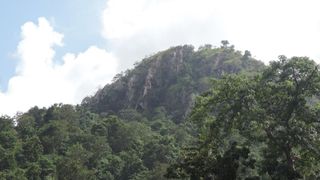Earth's 1st continents arose hundreds of millions of years earlier than thought

Earth's first continents, known as the cratons, emerged from the ocean between 3.3 billion and 3.2 billion years ago, a new study hints.
This pushes back previous estimates of when the cratons first rose from the water, as various studies suggested that large-scale craton emergence took place roughly 2.5 billion years ago.
"There was no uncertainty that continents were partly sticking out of water as early as 3.4 billion years ago," said Ilya Bindeman, a professor of geology at the University of Oregon, who was not involved in the new study. That's because scientists have found sedimentary rocks — which form from the broken-up bits of other rocks that have undergone erosion and weathering — that date back to that era. Such sedimentary rocks could only form once land broke through the surface of early Earth's oceans.
Related: 50 interesting facts about Earth
But although geologists knew that at least part of the cratons must have been exposed more than 3 billion years ago, the exact timing and extent of their emergence remained a matter of debate, Bindeman told Live Science in an email. The study authors suggest that entire cratons, not just small patches of land, emerged from the oceans 3.3 billion years ago, even though the planet then lacked the "modern-style plate tectonics" needed to drive those floating bits of crust upward, he said.
For the new study, published Nov. 8 in the journal Proceedings of the National Academy of Sciences (PNAS), the authors trekked to the Singhbhum Craton, located in eastern India. "Pockets" of ancient sedimentary rocks had previously been found at the craton, and the team wanted to determine their exact ages and the nature of how they formed, said first author Priyadarshi Chowdhury, a postdoctoral research fellow at Monash University's School of Earth, Atmosphere and Environment in Melbourne, Australia.
"When we joined all the sedimentary pockets together, we found that all of them kind of formed simultaneously," in river or beach-like environments, Chowdhury told Live Science. That would imply that much of the craton became exposed to air and running water at the same time. "That was like the point when we realized, okay, we are onto something."
Sign up for the Live Science daily newsletter now
Get the world’s most fascinating discoveries delivered straight to your inbox.
To date the rocks, the team examined them for tiny crystals called zircons, which contain the radioactive element uranium. "We take the zircons out of the rocks — that's a very tedious process," Chowdhury said. "You can imagine, finding zircons is like finding a needle from a haystack," because zircon grains measure mere dozens of microns across, making them similar to very fine sand.

After collecting the zircons, the team zapped the crystals with a laser to reveal their chemical composition, using a technique called mass spectrometry. Uranium decays to lead at a fixed rate, so by examining the ratio of uranium to lead in each sample, the team could determine the age of the rocks; from that, they estimated that the entire craton became exposed around 3.2 billion to 3.3 billion years ago.
Related: 10 ways the Earth has changed forever
But what forces first drove the Singhbhum Craton out of the water? To figure that out, the authors sampled igneous rocks from the cratons, meaning rocks formed through the crystallization of hot magma; these igneous rocks lie just below the sedimentary rocks in the craton, forming a kind of "basement," Chowdhury said.
The chemical composition of these igneous rocks encodes information about the pressure and temperature at which they first formed, he said. Taking these chemical compositions into account, the team built a model to recreate the conditions that formed the rocks, and later, forced them through the ocean's surface.
The model suggests that, about 3.5 billion to 3.2 billion years ago, hot plumes of magma beneath the crust caused portions of the craton to thicken and become enriched with buoyant, lightweight materials, like sicilia and quartz. This process left the craton "physically thick and chemically light," as compared to the denser rock surrounding it, and thus buoyed the land mass up and out of the water, Chowdhury said.

Other cratons contain sedimentary rocks of similar ages to the Singhbhum Craton in India, including the Kaapvaal Craton in South Africa and Pilbara Craton in Australia. Based on the new study, it's possible that these cratons also emerged, in full, more than 3 billion years ago, the study authors wrote in their report. But while this wholesale emergence of continents is possible, several huge questions remain regarding this period of Earth's history: Exactly how much land was exposed at one time, and how long did these landmasses remain above water? At this point, the answers to both questions remain a mystery, Chowdhury said.
"Many rocks that could have emerged are now subducted," meaning they slipped underneath a neighboring chunk of the crust and got pushed into the mantle beneath, Bindeman said. In general, continental crust is less subject to subduction than the crust found beneath the ocean, but it can still be deformed and damaged by various forces acting at and below the crust, Eos reported. "The older you go into the geological record the fewer and fewer rocks … you'll find."
But even if some cratons dipped down into the sea shortly after their first above-water appearance, they would have triggered significant changes in the surface world, Chowdhury noted.
For instance, the first appearance of land on Earth would have kicked off processes like weathering and erosion, and these, in turn, would carry elements such as phosphorus into the ocean, providing key ingredients for the planet's first lifeforms. Namely, organisms known as cyanobacteria, or blue-green algae, would eventually come to populate the oceans, and through photosynthesis, introduce oxygen into the atmosphere, Chowdhury said.
Before oxygen became a major component of Earth's atmosphere, around 2.45 billion years ago, there's evidence of so-called oxygen whiffs cropping up here and there, Chowdhury said. These whiffs, he theorizes, may be related to the first emergence of cratons, in that small crops of cyanobacteria may have emerged near the landmasses and increased oxygen levels on a local scale.
At the same time, the weathering of materials like silica on land, would have pulled carbon dioxide from the atmosphere, cooling the planet on a regional scale, he said. This side effect of weathering silica is well-known; in the present-day, the weathering of silicate rocks pulls an estimated 150 million to 330 million tons (136-299 million metric tons) of carbon dioxide from the atmosphere each year, Eos reported.
Regarding when and how the cratons fully emerged, "the debate will likely continue," Bindeman said. In theory, the discovery of new cratons would help settle the matter once and for all, he added.
"Everybody keeps studying a handful of localities that are long known," but undiscovered outcrops may lie hidden in unexplored regions of Antarctica or Russia, and finding them could help fill in the global picture of when and how Earth's first continents appeared, Bindeman told Live Science.
Originally published on Live Science.

Nicoletta Lanese is the health channel editor at Live Science and was previously a news editor and staff writer at the site. She holds a graduate certificate in science communication from UC Santa Cruz and degrees in neuroscience and dance from the University of Florida. Her work has appeared in The Scientist, Science News, the Mercury News, Mongabay and Stanford Medicine Magazine, among other outlets. Based in NYC, she also remains heavily involved in dance and performs in local choreographers' work.
Most Popular



